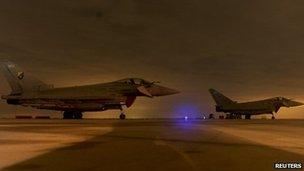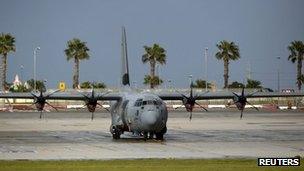Counting the costs of Libya mission
- Published

RAF aircraft carried out 3,000 missions over seven months
Nato is expected to formally announce an end to its military operation over Libya at a meeting in Brussels on Friday. It follows the unanimous vote at the UN Security Council to lift the no fly zone. The announcement would signal the end of a complex military mission, now in its seventh month. But what are the lessons for Nato and the UK in particular?
With the quiet help of America's massive military machine, Nato managed to sustain the Libya operation.
Overall its warplanes flew more than 26,000 sorties, including nearly 10,000 strike sorties. British aircraft alone carried out 3,000 missions - 2,000 of them strike sorties, about one fifth of the Nato total.
The Ministry of Defence says RAF Tornados and Typhoons, along with the Army's Apache ground attack helicopters, also successfully hit 640 military targets.
Even before the operation officially ended, the MoD and its military commanders have begun to ask the question of what lessons can be learnt.
Among the issues being addressed is whether the deep defence cuts, announced by the coalition government last autumn, left the nation and the alliance exposed.
Though Nato took over the mission it still depended on American help to provide refuelling planes and intelligence, surveillance and reconnaissance assets such as the predator drone.
France, Britain and its partners could not have done this alone.
Then there's the question of how much it all cost.
The MoD's current projection, based on the mission continuing till mid December, is that it will cost the British taxpayer around £300m - £160m for operational costs such as fuel, logistics and accommodation and £140m to replenish munitions.
At its peak some 2,300 British service personnel were deployed; 1,420 precision guided bombs and missiles released; the Army aircorps Apaches launched about 110 hellfire missiles and CR-V rockets and fired more than 4,000 rounds from their 30mm cannon; from the sea Royal Navy warships fired 240 high explosive or illumination rounds.
And it's not all over yet.
Despite the expected formal announcement that Nato's mission is over, Western powers are likely to be involved in Libya for some considerable time.
A small team of British military advisers remain on the ground to aid the National Transitional Council. US and British experts are also trying to ensure that the surfeit of weapons in the country do not end up in the wrong hands.

The UK estimates it will spend £160m on operational costs in Libya
It's believed that there are still hundreds of portable surface to air missiles in Libya. The head of the UK's Joint Operations, Air Marshall Sir Stuart Peach, has warned of the "risk of proliferation".
Those Nato members who took part in Operation Unified Protector are, understandably, claiming success.
Though it is worth remembering that in the early days there were plenty of questions as to how long the alliance could sustain the tempo of operations and bring about an end to the fighting.
Without a specific UN mandate authorising the toppling of Colonel Gaddafi there was no clear end game.
There were even those who supported the mission who seemed to doubt whether Nato was up to the job.
During the summer the outgoing US Defense Secretary Robert Gates criticised the alliance's capabilities, highlighting the fact that some member states were already running short of munitions.
Any strains within the alliance, though, were eased by the rapid collapse of pro-Gaddafi forces. Any fears that a long protracted campaign would reveal serious cracks in the alliance disappeared with the death of the Libyan dictator himself.
A clear cut end to the mission - even though Nato still insists he was never a target.